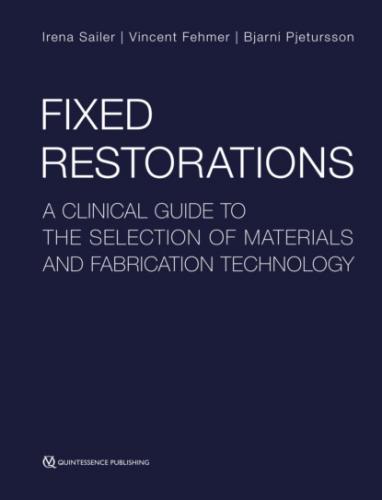Fixed Restorations. Irena Sailer
with a wax plate in the conventional workflow (Fig 1-2-7). CO is traditionally defined as the occlusion of opposing teeth when the mandible is in CR position.
Fig 1-2-7a and 1-2-7b Centric occlusion (CO) is registered by putting a double layer wax plate with additional aluminum wax dots on the occlusal surface of the maxillary teeth; the patient is asked to close their jaws in the centric relation (CR) position until touching the wax dots.
Maximal intercuspal position
Maximal intercuspal position (MIP) should be registered with a wax or a bite paste (Fig 1-2-8). MIP is defined as the complete intercuspation of the opposing teeth independent of condylar position, sometimes referred to as the best fit of the teeth regardless of the condylar position (CR).
Fig 1-2-8 Maximal intercuspal position (MIP) can be registered with a double layer wax plate.
Occlusal position
The occlusal position or the Angle classification should be registered (Fig 1-2-9). This represents the relationship of the mandible and maxilla when the jaw is closed and the teeth are in MIP.
Fig 1-2-9a to 1-2-9c Schematic drawing showing (a) Angle Class I, (b) Angle Class II, and (c) Angle Class III occlusal relationship of the first molars, canines, and anterior teeth.
Premature contacts and sliding
Premature contacts and sliding in MIP should be registered and a decision should be made whether it is reasonable to reduce the premature contacts to make MIP = CO prior to the insertion of a new restoration. This is simply done to stabilize the occlusion, not to treat or prevent temporomandibular disorders40,41. According to studies evaluating the location of CO and MIP, the incidence of patients was MIP = CO and ranged from 10% to 43%42–44. The position of the premature contacts can be evaluated intraorally, or on articulated study casts mounted according to a CO registration.
Occlusal contacts
The occlusal contacts on the working side during laterotrusion should be analyzed and recorded. According to these contacts the patients are classified using canine guidance (Fig 1-2-10), in which the vertical and horizontal overlap of the canine teeth discludes the posterior teeth in the excursive movements of the mandible. In patients with group function (Fig 1-2-11), multiple contact relations between the maxillary and mandibular teeth exist on the working side at lateral movements, whereby simultaneous contact of several teeth as a group distributes the occlusal forces.
Fig 1-2-10 Canine guidance on the working side in lateral movements.
Fig 1-2-11 Group function on the working side in lateral movements.
The absence or presence of occlusal contacts on the non-working balance side should be evaluated and registered.
The absence or presence of posterior occlusal contacts in the protrusive movement of the mandible should be evaluated and registered.
Vertical overlap
The vertical overlap is registered in millimeters. If a deep bite (Fig 1-2-12) is present it must be analyzed, whether it is a primary deep bite with a skeletal basis, or a secondary deep bite caused by a vertical collapse due to a loss of posterior teeth or significant tooth wear.
Fig 1-2-12 Partially edentulous patient with a combination of primary and secondary deep bite due to loss of molar support and significant tooth wear.
Horizontal overlap
The horizontal overlap is registered in millimeters (Fig 1-2-13).
Fig 1-2-13a to 1-2-13d Horizontal overbite can be registered by placing a finger on the buccal surface of the mandibular front teeth at the level of the incisal edge of the maxillary front teeth. The distance from the incisal edge of the mandibular teeth to the finger position, representing the overbite, can then be measured in millimeters with a periodontal probe.
Interocclusal rest space
The interocclusal rest space is evaluated. The normal distance between the occluding surfaces of the maxillary and mandibular teeth in resting position should be around 3 mm.
Crowding
Crowding of teeth and teeth that are in a reverse articulation (cross-bite) or out of occlusion (scissor bite) should be noted (Fig 1-2-14).
Fig 1-2-14 Patient with deep bite and premolars that are out of occlusion or in so-called scissor bite. A significant increase of the vertical dimension of the occlusion (VOD) is needed to restore this sextant.
Parafunctions
Any signs of bruxism or parafunctions should be evaluated and registered (Fig 1-2-15). Furthermore, signs of trauma from occlusion and the possible etiology should be evaluated. The manifestation of trauma from occlusion can be diagnosed through functional disturbances, through changes in the hard structure of teeth or through periodontal changes. Embodiment of trauma from occlusion on tooth structure can be excessive mechanical tooth wear, both attrition and abfraction, or even tooth fractures. The periodontal changes can be progressive tooth mobility due to widening of the periodontal ligament, dull percussion sound, soreness of teeth, tipping of teeth, root resorption, or hypercementosis.
Fig 1-2-15 Patient suffering from significant tooth wear due to bruxism and parafunctions.
Tooth mobility
The etiology of increased tooth mobility has to be addressed. The most frequent reason for increased tooth mobility is reduced bone support due to periodontal disease. Other factors that can cause increased mobility are: occlusal trauma with widening of the periodontal ligament; overload due to poorly designed restorations (Fig 1-2-16); trauma, periodontal abscesses; orthodontic treatment; tumors; or combination of different factors.
Fig
